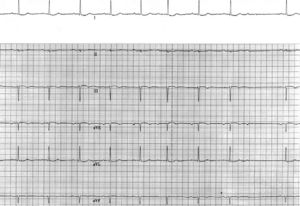Rhythm Puzzle: An irregular rhythm at older age - Answer
| Author(s) | A.A.M. Wilde | |
| NHJ edition: | 2007:4,157 | |
| These Rhythm Puzzles have been published in the Netherlands Heart Journal and are reproduced here under the prevailing creative commons license with permission from the publisher, Bohn Stafleu Van Loghum. | ||
| The ECG can be enlarged twice by clicking on the image and it's first enlargement | ||
An 86-year-old man presents in your outpatient clinic with stable angina pectoris (NYHA 2/4). There is no further medical history with the exception of hypertension for which he is being treated with metoprolol 100 mg daily. Physical examination reveals no abnormalities. His ECG is shown in figure 1 (only extremity leads).
What is your electrocardiographic diagnosis?
Answer
The ECG shows sinus rhythm with a rate slightly below 60 beats/min. The PR interval is slightly prolonged (220 ms) and QRS width is normal (80 ms). The electrical axis is at –30°. An old inferior myocardial infarction might be present. The rhythm is slightly irregular. This refers in particular to the 6th P wave, which comes earlier and is slightly different in morphology (most clearly seen in lead III). Hence, this should be referred to as an atrial extrasystole. The PR interval of this extrasystole is further prolonged (360 ms). Although atrial prematurity is generally followed by hampered AV-nodal conduction (i.e. this is normal AV-nodal physiology), a normal AV node should be expected to have recovered completely from previous conduction at these long coupling intervals. Hence, and as also indicated by the baseline prolonged PR interval, his AV node is no longer functioning optimally. The β-blocker might of course be contributing to that. At the most right part of the ECG a long RR interval is seen. Again an atrial extrasystole is present which is now blocked. The coupling interval of this extrasystole is shorter than that of the first atrial extrasystole and is, not unexpectedly given the significantly hampered AV conduction of the first extrasystole, now blocked. The PR interval of the following sinus beat is within normal limits, one more argument for a functional defect in a less than optimally functioning AV node.
In summary: sinus rhythm with first-degree AV block, (blocked) atrial extrasystoles.
